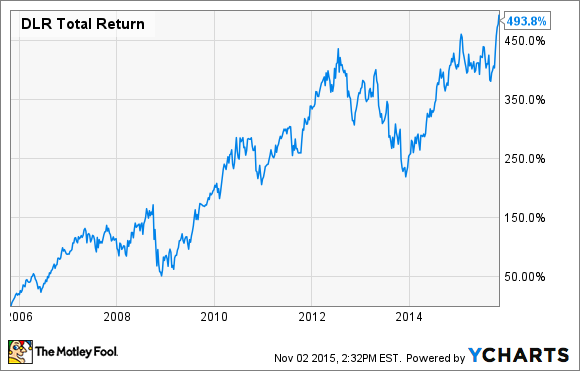
Image source: Wikipedia user Victorgrigas.
Digital Realty Trust (DLR -1.30%), a REIT that specializes in data center properties, has done well for its investors, returning a total of 494% over the past decade. Most recently, its third-quarter earnings handily surpassed analysts' expectations.
Here are five things Digital Realty's management had to say during the earnings call that could give investors a sense of whether or not its future is as bright as its past.
1. The Telx integration: Cost synergies and more
The most notable occurrence of Digital Realty's second quarter was the completion of the $1.886 billion acquisition of Telx, and management had a few comments about it.
First, CEO William Stein praised the entire finance, accounting, and investment teams, saying they did a great job facilitating the transaction. He also reiterated that Digital Realty expects $15 million of cost synergies, which they expect to benefit from in 2016.
More importantly, Stein outlined Digital Realty's priorities for Telx going forward. Not surprisingly, the No. 1 priority is leasing up Telx's existing vacancies -- which I've written before could translate to an additional $65 million in annual income, even at a conservative 80% occupancy target. Next, Digital Realty will turn over to Telx the inventory in buildings where Telx already operates. Third, Telx will take over Digital Realty's existing colocation business, which management believes will be the most effective method of operation. Finally, the last phase will be expansion of the colocation and interconnection businesses, both domestically and internationally.
Management also stressed that the priority will be getting all of this done correctly as opposed to quickly. As Stein said, "This is really our first major acquisition of an operating platform and we want to make sure that we do this right."
2. Strategic capital allocation
Smart REIT managers don't just acquire properties in order to hold onto them forever. Rather, they are constantly evaluating the best uses of a company's capital -- there are many situations in which it makes better business sense to sell a property and move on. Possible reasons for this include lack of demand in a specific geographic location, properties that no longer fit into the company's long-term vision, or properties that have appreciated in value to the point where the capital could be better redeployed elsewhere.
Digital Realty is in the middle of a capital recycling initiative, and it currently has seven properties on the market -- one of which is under contract, and six that are being negotiated. Stein said the company expects to receive more than $150 million in proceeds and for the program to be complete by the end of the year.
As far as deploying capital is concerned, the company expects a renewed effort on expansion in the coming years. "In contrast to the past 18 months, we expect to be committing capital to expand over the intermediate term. We intend to expand on our existing campuses, expand in existing markets, and grow opportunistically in new markets," said Stein.
3. A good environment for growth
The growth numbers from the quarter looked good. Core FFO per share (think of this as the EPS metric of real estate) grew by 8.2% year over year, and revenue was up by 5.8%. And, the company signed new leases at a GAAP rent increase of 11%. It's clear from the conference call that management thinks this will continue.
Stein made a point to address the decline in global economic growth, and wants to put investors' fears at ease. "From where we sit ... the rumors of the tech-wreck coming back to the future have been greatly exaggerated."
In other words, the need for data will continue to grow, creating tremendous demand for data center properties. In fact, cloud IP traffic is projected to increase at a 33% annual rate until 2019, and some other forms of data, such as mobile, are expected to grow even faster.
Digital Realty has already secured plenty of new lending commitments, and the company foresees a good amount of pre-leasing activity at its soon-to-be-developed properties.
4. The results are even better than they appear
Although the reported revenue and FFO growth was impressive all by itself; management wants investors to realize that the performance was better than it appears. Specifically, the adverse effects of foreign exchange rates have been a drag on Digital Realty's numbers.

Source: Digital Realty.
CFO Andrew Power said, "FX continues to represent roughly a 300 basis points drag on the year-over-year growth in our reported results from the top line to the bottom line." In the company's earnings presentation, it reveals that if not for the FX impact, revenue would have grown 8.8% year over year (the reported growth was 5.8%), and core FFO per share would have grown by 11.5% (8.2% reported).
5. The company is getting more efficient
Finally, Digital Realty wants investors to know that not only does it want to be the No. 1 data center REIT, but it wants to run the most efficient operation possible -- an area where tremendous progress has been made.
During the third quarter, Digital Realty's return on invested capital (ROIC) improved by 10 bps from the previous quarter and has improved by a total of 130 bps (1.3%) since the fourth quarter of 2013. Stein commented that this is a "remarkable achievement for a portfolio of our size," and Power added, "the bottom line is [that] the quality of earnings is improving, and the growth in cash flow is accelerating."
In a nutshell, Digital Realty continues to surpass expectations, and it continues to strive to do the same in the future. Management seems pleased with how things are going, and it will be interesting to see how the Telx integration and anticipated expansion plans play out in future quarters.





